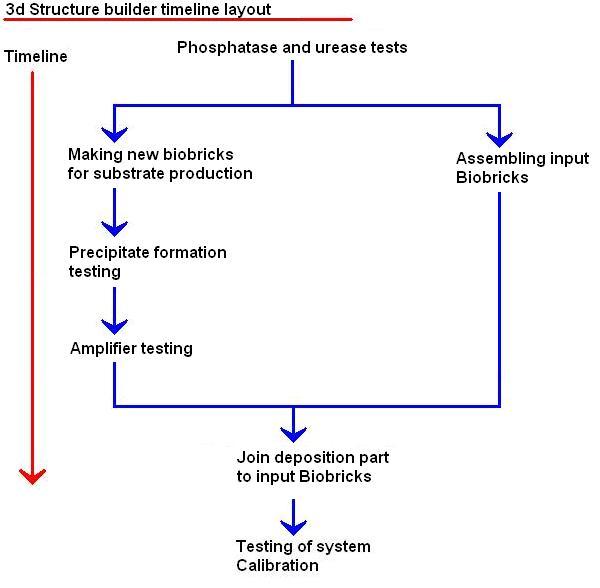Idea 6/11
From 2006.igem.org
(→Calcite/Calcium Phosphate Project (Idea 6/11)) |
(→Parts Required) |
||
| (15 intermediate revisions not shown) | |||
| Line 7: | Line 7: | ||
== Background == | == Background == | ||
| + | |||
| + | [[Image:Construction.gif|right|Bacterial Building Site]]This project stems from the thought that it would be cool to build an actual biological brick. A way in which this could be done is by engineering the bacteria so that a hard substance is produced. | ||
| + | |||
| + | An initial extension of this idea was to get bacteria to produce a hard material in response to one stimulus and then to degrade this material in response to another. It has also been postulated that it may be possible to produce synthetic materials, for example pearl, by modifying bacteria such that they produce different layers of material. Another route that could be taken is that of modifying the bacteria so that they produce a defined pattern made from the solid substance. | ||
| + | |||
| + | The most feasible idea appears to be that of engineering bacteria to lay down a solid substance on a path that can be defined by the user. In order to create this pattern, a good input appears to be UV light which can be used in a similar way to a pen. This is analogous to the Etch-a-Sketch device produced by Harvard in the iGEM competition last year. However, instead of the output being fluorescence, it will be the secretion of a solid substance. The two options that seem best for this substance are calcium carbonate and calcium phosphate. Initial experiments will be required to determine which of these will work best. | ||
| + | |||
| + | In essence, the plan is to produce a 3-D biofilm which could have many uses. For example, it may eventually be possible to produce biodegradable scaffolds for use in tissue engineering. Biodegradable scaffolds can be seeded with donor cells and growth factors, followed by culturing and implantation of the scaffolds in order to produce healthy, new tissue. There is a great need for bone substitutes that are required to fulfil many criteria in order to be ideal. Currently, there is no such material that could be classed as being ideal and it may be that a new route to synthesise these materials is necessary. Who knows, maybe bacteria could be the way forward… | ||
== Possible Methods == | == Possible Methods == | ||
Initial colony makes phosphatase or urease in response to stimulus from UV, or absence of UV signal. The enzyme catalyses the conversion of calcium and phosphate/carbonate ions in the medium into calcium phosphate or calcium carbonate. An amplifier can be incorporated if the resulting amounts of 'hard' material need to be increased. | Initial colony makes phosphatase or urease in response to stimulus from UV, or absence of UV signal. The enzyme catalyses the conversion of calcium and phosphate/carbonate ions in the medium into calcium phosphate or calcium carbonate. An amplifier can be incorporated if the resulting amounts of 'hard' material need to be increased. | ||
| + | [[Image:3d_Structure_builder_timeline_layout.JPG|3d Structure builder timeline layout]] | ||
| - | ==Problems== | + | ==Possible Problems== |
| - | + | ||
| - | + | ||
How will the Calcium compound be restricted to only the areas activated? It could diffuse around the area and lose the original pattern. | How will the Calcium compound be restricted to only the areas activated? It could diffuse around the area and lose the original pattern. | ||
| + | How to activate the phosphatase or urease AND switch it off. | ||
| - | + | Possible that phosphatase and urease don't cause calcium compound to precipitate in sufficient quantities. | |
| - | |||
| - | + | ==Parts Required== | |
| - | + | LuxR gene attached to a regulator responsive to light. | |
| + | LuxR/cI responsive promoter is connected to the gene for urease (or lysine decarboxylase, or ornithine decarboxylase) which, if activated, catalyses the conversion of urea into ammonia and carbon dioxide, raising the pH. Alternatively, if a phosphatase can be found the promoter can regulate this to result in the release of phosphate ions which can react with calcium ions and form calcium phosphate. | ||
| + | |||
| + | cI gene attached to a regulator responsive to another stimulus. | ||
== Experiments Required == | == Experiments Required == | ||
| Line 36: | Line 46: | ||
Urease vs. phosphatase. | Urease vs. phosphatase. | ||
| - | # | + | #Proteus vulgaris produces urease and colonies of P. vulgaris lower the pH by producing ammonia. A test can be done with Proteus vulgaris to see if this causes calcium to precipitate from the medium with some different concentrations of calcium ions. Locate an E. coli phosphatase and do a similar experiment, to see which compound is the 'best' solid material. |
| - | + | #Locate urease/phosphatase in E. coli that is suitable. Find optimum CaCl2 concentrations, phosphate donor concentrations in medium. (Just test with genes coupled with constitutive promoters?) Can also see what happens when the medium, and if the medium becomes depleted of calcium or phosphate ions. End - Find a suitable ratio of calcium to phosphate ions in medium. | |
| - | + | #Urease increases pH, measure pH change caused by different densities of bacteria, find if the pH change produced by E. coli in a lawn is suitable (high enough) for causing calcite to precipitate. | |
| - | #Locate urease/phosphatase in E. coli that is suitable. | + | |
| - | + | ||
| - | End - Find a suitable ratio of calcium to phosphate ions in medium. | + | |
| - | + | ||
| - | #Urease increases pH, measure pH change caused by different densities of bacteria, find if the pH change produced by E. coli in a lawn is suitable for causing calcite to precipitate. | + | |
| - | [http://2006.igem.org/ | + | [http://2006.igem.org/University_of_Edinburgh_2006 Main page] |
Latest revision as of 15:20, 11 July 2006
Contents |
Calcite/Calcium Phosphate Project (Idea 6/11)
Aim
To create a 3D structure in a defined area using bacteria which can precipitate out a calcium compound.
Background
This project stems from the thought that it would be cool to build an actual biological brick. A way in which this could be done is by engineering the bacteria so that a hard substance is produced.An initial extension of this idea was to get bacteria to produce a hard material in response to one stimulus and then to degrade this material in response to another. It has also been postulated that it may be possible to produce synthetic materials, for example pearl, by modifying bacteria such that they produce different layers of material. Another route that could be taken is that of modifying the bacteria so that they produce a defined pattern made from the solid substance.
The most feasible idea appears to be that of engineering bacteria to lay down a solid substance on a path that can be defined by the user. In order to create this pattern, a good input appears to be UV light which can be used in a similar way to a pen. This is analogous to the Etch-a-Sketch device produced by Harvard in the iGEM competition last year. However, instead of the output being fluorescence, it will be the secretion of a solid substance. The two options that seem best for this substance are calcium carbonate and calcium phosphate. Initial experiments will be required to determine which of these will work best.
In essence, the plan is to produce a 3-D biofilm which could have many uses. For example, it may eventually be possible to produce biodegradable scaffolds for use in tissue engineering. Biodegradable scaffolds can be seeded with donor cells and growth factors, followed by culturing and implantation of the scaffolds in order to produce healthy, new tissue. There is a great need for bone substitutes that are required to fulfil many criteria in order to be ideal. Currently, there is no such material that could be classed as being ideal and it may be that a new route to synthesise these materials is necessary. Who knows, maybe bacteria could be the way forward…
Possible Methods
Initial colony makes phosphatase or urease in response to stimulus from UV, or absence of UV signal. The enzyme catalyses the conversion of calcium and phosphate/carbonate ions in the medium into calcium phosphate or calcium carbonate. An amplifier can be incorporated if the resulting amounts of 'hard' material need to be increased.
Possible Problems
How will the Calcium compound be restricted to only the areas activated? It could diffuse around the area and lose the original pattern.
How to activate the phosphatase or urease AND switch it off.
Possible that phosphatase and urease don't cause calcium compound to precipitate in sufficient quantities.
Parts Required
LuxR gene attached to a regulator responsive to light.
LuxR/cI responsive promoter is connected to the gene for urease (or lysine decarboxylase, or ornithine decarboxylase) which, if activated, catalyses the conversion of urea into ammonia and carbon dioxide, raising the pH. Alternatively, if a phosphatase can be found the promoter can regulate this to result in the release of phosphate ions which can react with calcium ions and form calcium phosphate.
cI gene attached to a regulator responsive to another stimulus.
Experiments Required
Experiments for Idea 2.
Is calcium phosphate or calcite better at precipitating?
Urease vs. phosphatase.
- Proteus vulgaris produces urease and colonies of P. vulgaris lower the pH by producing ammonia. A test can be done with Proteus vulgaris to see if this causes calcium to precipitate from the medium with some different concentrations of calcium ions. Locate an E. coli phosphatase and do a similar experiment, to see which compound is the 'best' solid material.
- Locate urease/phosphatase in E. coli that is suitable. Find optimum CaCl2 concentrations, phosphate donor concentrations in medium. (Just test with genes coupled with constitutive promoters?) Can also see what happens when the medium, and if the medium becomes depleted of calcium or phosphate ions. End - Find a suitable ratio of calcium to phosphate ions in medium.
- Urease increases pH, measure pH change caused by different densities of bacteria, find if the pH change produced by E. coli in a lawn is suitable (high enough) for causing calcite to precipitate.
[http://2006.igem.org/University_of_Edinburgh_2006 Main page]

